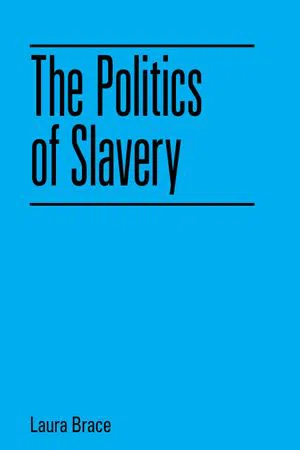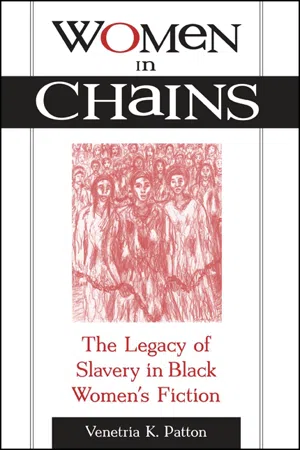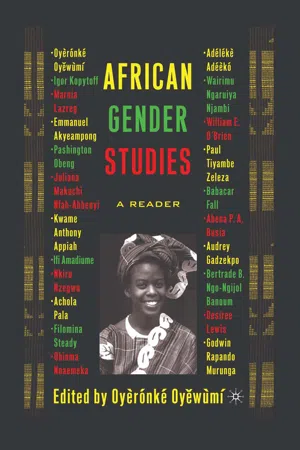History
Slavery and Gender
"Slavery and Gender" refers to the intersection of slavery and gender roles, particularly in the historical context. It encompasses the ways in which gender influenced the experiences of enslaved individuals, including the types of labor they were assigned, their treatment, and their opportunities for resistance. This area of study sheds light on the complex dynamics of power, exploitation, and resistance within the institution of slavery.
Written by Perlego with AI-assistance
Related key terms
1 of 5
7 Key excerpts on "Slavery and Gender"
- eBook - PDF
Gender, Mastery and Slavery
From European to Atlantic World Frontiers
- William Foster(Author)
- 2009(Publication Date)
- Bloomsbury Academic(Publisher)
One fundamental pain of servitude for women and men was their ina-bility to define their own family life, location, social role, and sexual expression. 4 GENDER, MASTERY AND SLAVERY Traditionally, studies of slavery have presented ‘men’ and ‘women’ as sepa-rate and mutually opposed camps. Accordingly, four major questions have preoccupied historians of gender and slavery. First, did slavery exaggerate and ultimately expand the private and public power of an elite patriarch – acceler-ating male prerogative? Second, were the wives and daughters of these men, so-called ‘free’ women, merely the most privileged ‘slaves’? Third, was the condition of bondage in its various forms harder to bear for men, whose man-hood was necessarily assaulted in the process of enduring servitude, or, was it worse for women, whose identities relative to work, family, and personal and bodily integrity were constantly besieged? Fourth, who was able to forge relationships with whom legitimately across slave/free boundaries? A rigorous overview of mastery exercised by men and women separately and together can help illuminate these older questions as well as help define new ones. To begin, historians and social theorists of gender and slavery have traditionally taken their cue from an archetypical antebellum American planta-tion mistress and diarist, Mary Boykin Chesnut, who wrote on the eve of the American Civil War that ‘there is no slave, after all like a wife ... all married women, all children and girls who live in their father’s house, are slaves.’ 7 Early studies of women and slavery virtually precluded the possibility of female mastery as separate from the authority of the master. One pioneer in this field, Gerda Lerner, outlined a link between women and slavery using evi-dence from ancient Mesopotamia, arguing that human slavery only became possible with the fundamental and general subordination of women in com-plex societies. - eBook - PDF
Sex and International Tribunals
The Erasure of Gender from the War Narrative
- Chiseche Salome Mibenge(Author)
- 2013(Publication Date)
- University of Pennsylvania Press(Publisher)
48 Slavery and slavery like practices have underpinned the major global forms of political oppression, including apartheid, colonization, and impe-rialism. Like all crimes against humanity, gender shapes and influences en-slavement. Here, I continue to press the argument made in earlier sections that a nar-row interpretation of gender leads scholars and legal practitioners to insert the rape of women into a legal narrative with no further attempts at inves-tigating the social and political nature and nuances of rape as well as other harms women experience. In the case of enslavement in the context of Sierra Leone’s armed conflict, TRC commissioners, the prosecutor, legal practitio-ners, and many human rights advocates have reduced women’s experience of enslavement to a coital and conjugal experience. Appending sex (and more recently marriage) to slavery has become the defining distinction between men and women’s experience of enslavement. According to this simplistic gender analysis, female slaves are sex slaves while their male counterparts are “just” slaves. Contrary to the increasingly popular representation by legal practitioners and scholars of the international crime of “sexual slavery,” with its emphasis on multiple or mass rapes of women and girls, Pamela Bridgewater (2005) provides an extensive review of the women’s experience of enslavement in the United States. She describes a wide range of gender-based forms of violence, ranging from denying new mothers the opportunity to recover from labor, to nurse and otherwise care for their children, and to have legal protection from rape (ibid.: 115–17). She makes the important point that rape was not only a condition inherent to the female slave experience, but unfettered sexual access to women was central to the right of ownership that slave owners exer-cised over slaves (ibid.: 117–18). - eBook - PDF
- Joseph C. Miller(Author)
- 2012(Publication Date)
- Yale University Press(Publisher)
As a result, rich ethnographic evidence illuminates the dynamics of slaving in contexts of hoe cultivation throughout the world. 27 In them, male outsiders are appropriated opportunistically, usually as captives taken in wars, and appreciated at least as much for their sheer subordinated presence, often in humiliating assignments to women’s work, as for any material thing they might produce. Or they may be employed in utterly excessive and superflu-ous displays to manifest or perform the prestige of patrons who can afford to indulge in such competition and whose prominence depends on such displays. The value even of male slaves rests not only on the personal obeisance they display, on their conspicuous availability for the most whimsical of demands rather than routine services necessary to the group, but also on the reserves of distinctive knowledge and skills from elsewhere that they might add to a local community’s ability to tap its resident talent to deal with unpredictable historical contingencies. 28 However, everywhere in the world before the sixteenth-century in the Americas, women and children were the great majorities of those enslaved. 29 They joined in performing the literally vital responsibilities of reproducing and maintaining the community assigned to females, most of them accorded internal status as wives, or, in the relational context of the communal ethos, 50 History as a Problem of Slaving eventually as mothers of the children they bore for it. The respectable wives controlled by the older men were protected by accessible and attentive kin of their own in neighboring communities, through guarantees affirmed in formal marriages that were more treaties between the groups of kin of the married pair than the isolating coupling of individuals established by marriages in the modern West. But isolated females acquired by slaving lacked the protec-tions of these ongoing local relationships. - eBook - PDF
American Slavery, American Imperialism
US Perceptions of Global Servitude, 1870–1914
- Catherine Armstrong(Author)
- 2020(Publication Date)
- Cambridge University Press(Publisher)
5 Gender and the Rhetoric of Slavery Since the late eighteenth and early nineteenth centuries, the conception of enslaved women had been a rhetorically significant one for abolitionists. Female chattel slaves in the transatlantic system were depicted as the doubly enslaved through virtue of their race and their gender, their race trapping them in a system of forced labour and their gender trapping them simultaneously in a system of forced breeding, sexual abuse and, for abolitionists, moral degradation. For such women there was no separa- tion between the world of work and the domestic sphere; they had little sense of a private family life but, rather, in all aspects of their personhood, were owned and possessed by men. Such women became the ideal victim, passive and without agency, requiring rescue and protection. More radical abolitionists fought against this rendering of the female slave as powerless, proclaiming women’s position as activists, campaigners and even resis- tance leaders in the struggle against slavery. Such patterns of interpreta- tion of the intersection between Slavery and Gender are mirrored in the post-emancipation period, with female victims foregrounded in popular literature enabling the transmission of both conservative and radical political messages about women’s place in society. Examining the position of women tells only half the story and, while as in most literature of the period, when discussing slavery, authors often treated the male experience as a normative one. In some cases, we can identify the problematising of masculinity within slavery and abolitionist discourse, alongside an analy- sis of the evolution of the domestic relationships of the formerly enslaved, allowing for comparisons between marriage and slavery. If they entered into marriage, even freedwomen and women born free in this period were not truly free. 185 - eBook - PDF
- Laura Brace(Author)
- 2018(Publication Date)
- Edinburgh University Press(Publisher)
What gives the production of a victim through a narrative of excessive dependence such traction in the current con-text of trafficking and migration? How is that traction related to the new abolitionism and its own investments in the role of the state, the veneer of humanitarianism and sexualised xenophobia? 192 The Politics of Slavery THE PROPERTIES OF SLAVERY This chapter seeks to interrogate what it means to claim that the bru-tally exploited and the radically excluded are the property of others. Modern slavery discourse focuses on ‘the individual lived experience of enslavement’ (O’Connell Davidson 2016, 248) where slavery ‘at its most essential is about control’. In 2012, Kevin Bales and others in the Research Network on the Legal Parameters of Slavery produced the Bellagio-Harvard Guidelines on the Legal Parameters of Slavery . These guidelines use the 1926 Convention of the League of Nations as the basis for their definition, meaning that they start from the premise of ownership and the rights and powers attaining to the right of owner-ship. They take these powers attaching to the right of ownership to mean powers that constitute control over a person in such a way as to deprive that person of his or her individual liberty with the intention of exploiting them. The exercise of this control is usually supported by and obtained through force, deception or coercion. For Bales, this mixture of control, ownership and force sets the parameters of ‘the fundamental social and economic relationship between two people that constitutes slavery’ (Bales 2012b, 283). It forms, he says, a bridge between the lived reality of enslavement and the legal definition. ‘Modern slaveholders’, Bales argues, exercise the powers attached to the right of ownership in the absence of the rule of law and in the con-text of illegality. - eBook - PDF
Women in Chains
The Legacy of Slavery in Black Women's Fiction
- Venetria K. Patton(Author)
- 2012(Publication Date)
- SUNY Press(Publisher)
This concession to the female’s cor-pulency is a sex or biological concession, while the beating signifies the refusal of gender concessions. These anecdotes illustrate that female slaves did not necessarily receive preferential treatment due to either their femininity or their maternity. Elizabeth Fox-Genovese notes that the law of slavery had no cause to differentiate between women and men. Its gender blindness, which acknowledged women only as the transmitters of the condition of slavery—and which did not recognize the rape of slave women as a crime—stolidly proclaimed that, in all formal respects, a slave was a slave was a slave. 27 According to the ideology of the period, all slaves were merely slaves, not men and women, however, the acknowledgment of fe-males as the transmitters of slavery creates a difference. This dif-ference, though, is not a gender difference, but a sex difference based on the female’s ability to give birth. When convenient, sex difference was recognized, but not gender difference. The degender-ing of slaves is a concept that goes back at least as far as Aristotle’s Politics , according to Spelman: “Aristotle does not allow for the possibility of slaves who are women, but only for slaves who are female—for he draws a distinction between woman and slave in such a way that ‘woman’ can only mean free woman, not slave woman.” 28 Spelman acknowledges the presence of female slaves by differen-tiating between sex and gender. However, Spillers inadvertently equates the two by using sex terms (female and male) to discuss gender issues. For example, in describing the slaves as cargo, she The Breeding Ground 9 states that the slaves are neither male nor female, but quantities. By using the terms “female” and “male,” rather than “woman” and “man,” Spillers suggests that the slaves were not sexed when they were actually seen as degendered, not unsexed. - eBook - PDF
African Gender Studies
A Reader
- Oyeronke Oyewumi(Author)
- 2016(Publication Date)
- Palgrave Macmillan(Publisher)
But it has done little, to date, to empower the vast majority of Africa’s econom- ically exploited and politically marginalized women (Brian, 1976; Nelson, 1981; Lewis, 1984; Mbilinyi, 1984; Overholt et al., 1985; Swantz, 1985; Munachonga, 1989). This is true even in the self-styled “socialist” regimes (Haile, 1980; Urdang, 1983; Fortman, 1982; Seidman, 1984). But African women in the post-independence era have not been passive victims. They continue to struggle both individually and collectively against their exploitation, oppression, and marginalisation, and to push open the doors to economic, political, social, and cultural empowerment (Obbo, 1980, 1986; Stamp, 1986; Dolphyne, 1991). Gendering African History It is quite evident that a lot of work has been done to recover women’s his- tory, but much more needs to be done. Also, the history that has so far been recovered has yet to be fully incorporated into the mainstream of African his- torical studies. Feminist historians, therefore, have to pursue a two-pronged agenda: writing women’s history and gender history. Women’s history, or “herstory,” is often seen as a reconstruction, a retrieval, of women’s experi- ences, expressions, ideas and actions. Gender has been defined as the chang- ing social organization and symbolic representation of sexual difference, the primary field within which or by means of which power is articulated or signified. As a concept it offers an epistemological redefinition of historical knowledge as construction rather than reconstruction (Scott, 1988: Chapters 1 and 2). To put it simply, it is said that in women’s history the pri- mary focus is on women, while in gender history it encompasses both men and women as gendered subjects. Apart from its explanatory power, the growing importance of gender as an analytical category reflected growing frustration among feminist histori- ans at the relatively limited impact that women’s history was having on main- stream historical studies.
Index pages curate the most relevant extracts from our library of academic textbooks. They’ve been created using an in-house natural language model (NLM), each adding context and meaning to key research topics.






